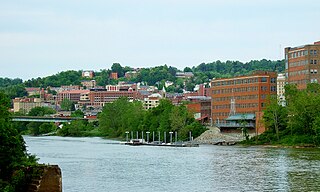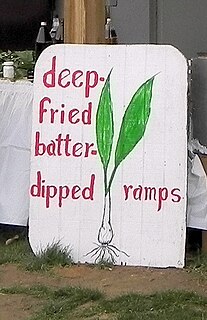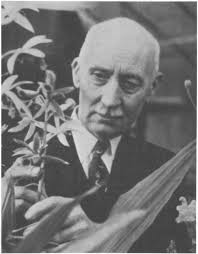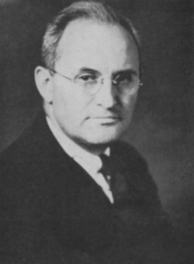
Morgantown is the county seat of Monongalia County, West Virginia, United States, situated along the Monongahela River. West Virginia University is located in the city. The population was 29,660 at the 2010 Census Bureau, making Morgantown the largest city in North-Central West Virginia. The Morgantown metropolitan area has a population of 138,176.

Allium tricoccum is a North American species of wild onion widespread across eastern Canada and the eastern United States. Many of the common English names for this plant are also used for other Allium species, particularly the similar Allium ursinum which is native to Europe and Asia.
Henry Horatio Dixon FRS was a plant biologist and professor at Trinity College Dublin. Along with John Joly, he put forward the cohesion-tension theory of water and mineral movement in plants.

John Kunkel Small was an American botanist.

Birbal Sahni FRS was an Indian paleobotanist who studied the fossils of the Indian subcontinent. He also took an interest in geology and archaeology. He founded what is now the Birbal Sahni Institute of Palaeobotany at Lucknow in 1946. His major contributions were in the study of the fossil plants of India and in plant evolution. He was also involved in the establishment of Indian science education and served as the President of the National Academy of Sciences, India and as an Honorary President of the International Botanical Congress, Stockholm.

Cranberry Glades — also known simply as The Glades — are a cluster of five small, boreal-type bogs in southwestern Pocahontas County, West Virginia, United States. This area, high in the Allegheny Mountains at about 3,400 feet (1,000 m), is protected as the Cranberry Glades Botanical Area, part of the Monongahela National Forest. This site is the headwaters of the Cranberry River, a popular trout stream, and is adjacent to the nearly 50,000-acre (200 km2) Cranberry Wilderness.

Mollugo verticillata, the green carpetweed, is a rapidly spreading annual plant from tropical America. In eastern North America, it is a common weed growing in disturbed areas. It forms a prostrate circular mat that can quickly climb over nearby plants and obstacles. The species has been reported from every state in the United States except Alaska, Hawaii, and Utah, as well as from British Columbia, Manitoba. Ontario, Quebec, New Brunswick and Nova Scotia. Although considered an invasive weed, M.verticillata is also known to be edible. Archaeological evidence has shown that M. verticillata has been in North America for about 3000 years. Sometimes also referred to as "Indian chickweed", in China this plant is referred to as zhong leng su mi cao.
Allen Charles Skorepa was an American lichenologist, and a specialist on the lichens of Maryland. The standard author abbreviation Skorepa is used to indicate this person as the author when citing a botanical name.

Charles Frederick Millspaugh (1854–1923) was an American botanist, born at Ithaca, N.Y., and educated at Cornell and the New York Homeopathic Medical College. For several years he practiced medicine and from 1891 to 1893 taught botany at West Virginia University. In 1894 he was appointed curator of the department of botany of the Field Museum of Natural History; from 1897 to 1923 he was professor of medical botany at the Chicago Homeopathic Medical College. He was also lecturer on botany at the University of Chicago. Millspaugh carried on explorations in the West Indies, Brazil, and other parts of South America, and was the author of American Medical Plants (1887); Flora of West Virginia (1891); and many articles in scientific and popular journals.
Jacob Young is an American screenwriter, cinematographer, film editor, and filmmaker best known for creating documentary films that explore eccentric people living in his native Appalachia.

Hu Maxwell was a local historian, novelist, editor, poet, and author of several histories of West Virginia counties.

Sods is a term used in the Allegheny Mountains of eastern West Virginia for a mountain top meadow or bog, in an area that is otherwise generally forested. The term is similar to that of a "grass bald", a more widespread designation applied throughout the central and southern Appalachian region.

Earl Lemley Core was a botanist and botanical educator, researcher, and author as well as a local West Virginia historian. He was founder of the Southern Appalachian Botanical Club and editor of its journal, Castanea, for thirty-five years. He was a teacher and professor at West Virginia University (WVU) from 1928 to 1972. He served for four years on the Morgantown City Council, and served as mayor of Morgantown for two years. The Earl L. Core Arboretum at WVU was named in his honor in 1967.

The Core Arboretum is a 91-acre (37 ha) arboretum owned by West Virginia University and located on Monongahela Boulevard in Morgantown, West Virginia. It is open to the public daily without charge.

Henry Wadsworth Gould is a Professor Emeritus of Mathematics at West Virginia University.
The Southern Appalachian Botanical Society was formed in 1935 at West Virginia University. The focus of the society has gradually changed and now includes the botany of the entire eastern United States, including the taxonomy, biogeography, ecology, physiology, and biochemistry of plants. The society has about 500 members.
Billie Lee Turner was an American botanist and the father of a geographer Billie Lee Turner II. He was a professor of botany at the University of Texas at Austin where he also directed the botany research programme and herbarium.

Jesse More Greenman was an American botanist. He specialized in tropical flora, with emphasis on plants from Mexico and Central America. He was an authority on the genus Senecio and noted for his work at the Missouri Botanical Garden.

Hugo Leander Blomquist was a Swedish-born American botanist. His well rounded expertise encompassed fungi, bacteria, bryophytes, algae, grasses, and ferns. The standard author abbreviation H.L.Blomq. is used to indicate this person as the author when citing a botanical name.

Elizabeth Ann “Betty” Bartholomew was an American botanist dedicated to the study of plant systematics. The standard author abbreviation E.A.Barthol. is used to indicate this person as the author when citing a botanical name.















